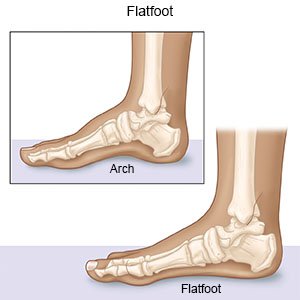Flatfoot in Children
Medically reviewed by Drugs.com. Last updated on Aug 4, 2025.
AMBULATORY CARE:
Flatfoot,
or fallen arches, is a condition that causes a lack of arch in your child's foot. Flatfoot is common in children younger than 6 years. It is normal for your baby not to have an arch that you can easily see. Babies have a fat pad that can cover the arch. You may be able to see the arch if you lift your baby so his or her feet dangle. The arch of the foot usually develops by 10 years, but your child may still have flatfoot as an adult. Flatfoot may be flexible or rigid. Flexible means your child has an arch when his or her foot is relaxed but not when he or she is standing. Rigid means his or her foot does not have an arch even when it is relaxed.
 |
Common signs and symptoms:
- The soles of your child's feet are flat on the floor when he or she stands
- Your child's toes or heels point out as he or she walks
- A tight Achilles tendon causes your child's heels to lift off the ground as he or she walks
- Pain in your child's heel or arch that is worse when he or she moves his or her foot
- Swelling on the inside part of your child's ankle
Call your child's doctor if:
- Your child has new or worsening symptoms.
- You have questions or concerns about your child's condition or care.
Treatment
may only be needed if your child has symptoms such as pain:
- A physical therapist can teach your child how to prevent overuse of muscles and tendons in his or her legs and feet. The therapist can also teach your child exercises to stretch tight tendons in his or her heel. The stretches may be the only treatment your child needs.
- Surgery may be needed if other treatments do not work. Your child may need to have a bone or tendon problem repaired. Your child's ankle may be made more stable, or his or her Achilles tendon may be made longer. Bones may be fused (joined) or separated.
Manage flatfoot:
- NSAIDs , such as ibuprofen, help decrease swelling, pain, and fever. This medicine is available with or without a doctor's order. NSAIDs can cause stomach bleeding or kidney problems in certain people. If your child takes blood thinner medicine, always ask if NSAIDs are safe for him or her. Always read the medicine label and follow directions. Do not give these medicines to children younger than 6 months without direction from a healthcare provider.
- Your child should rest his or her feet to relieve pain. Your child needs to avoid activities that make his or her symptoms worse. For some causes of flatfoot, your child's healthcare provider may recommend a cast or splint for a short time. This will completely rest your child's feet.
- Put orthotics in your child's shoes, as directed. An orthotic is a plastic device that slips into shoes. Orthotics will not cure flatfoot. They will only help relieve pain and help your child walk more easily. Talk to your child's provider about the kind of orthotics that are best for your child.
- Have your child wear shoes with flexible soles. These can help your child develop a normal foot motion as he or she walks. Ask your child's provider how old he or she should be to start wearing shoes.
- Talk to your child's provider about weight management. A healthy weight can relieve your child's symptoms and help prevent flatfoot. Ask the provider what a healthy weight is for your child. The provider can help you create a healthy weight loss plan for your child, if needed.
Follow up with your child's doctor as directed:
Your child may need more tests or treatment as he or she gets older. Your child's doctor may also refer him or her to a specialist if your child has a tight heel tendon, pain, stiffness, or trouble walking or running. Write down your questions so you remember to ask them during your visits.
© Copyright Merative 2025 Information is for End User's use only and may not be sold, redistributed or otherwise used for commercial purposes.
The above information is an educational aid only. It is not intended as medical advice for individual conditions or treatments. Talk to your doctor, nurse or pharmacist before following any medical regimen to see if it is safe and effective for you.
Further information
Always consult your healthcare provider to ensure the information displayed on this page applies to your personal circumstances.
